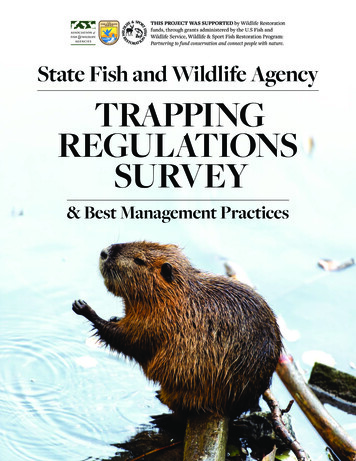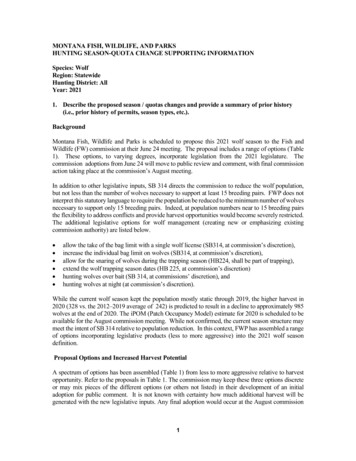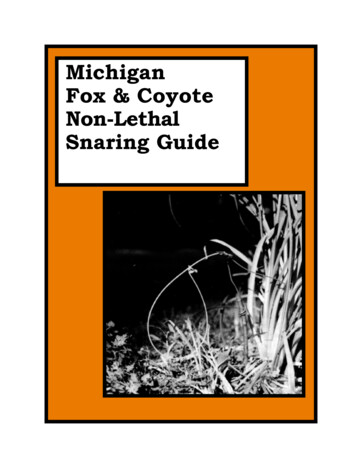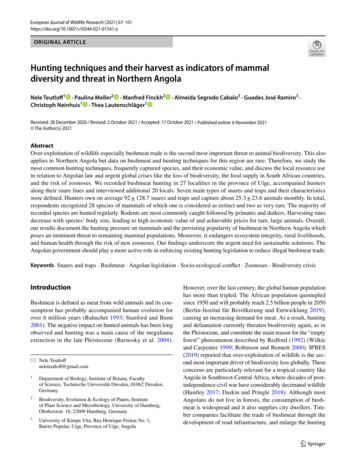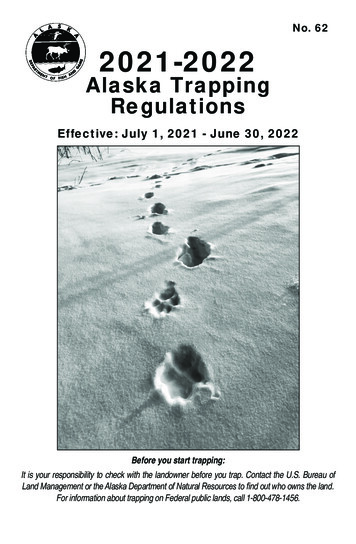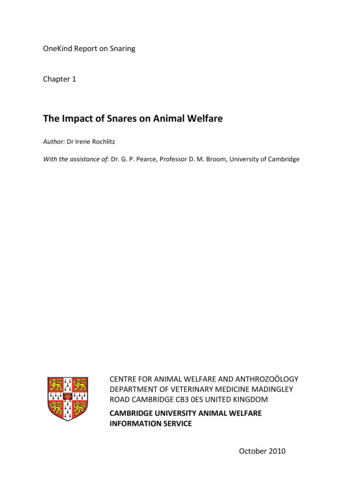
Transcription
OneKind Report on SnaringChapter 1The Impact of Snares on Animal WelfareAuthor: Dr Irene RochlitzWith the assistance of: Dr. G. P. Pearce, Professor D. M. Broom, University of CambridgeCENTRE FOR ANIMAL WELFARE AND ANTHROZOÖLOGYDEPARTMENT OF VETERINARY MEDICINE MADINGLEYROAD CAMBRIDGE CB3 0ES UNITED KINGDOMCAMBRIDGE UNIVERSITY ANIMAL WELFAREINFORMATION SERVICEOctober 2010
Chapter 1CONTENTSExecutive summaryIntroductionEvaluation of killing and restraining trapsKilling trapsRestraining trapsAssessment of injuriesBehavioural and physiological responsesTesting of restraining trapsKilling procedureSnaresBackground informationHow snares workExertional myopathy due to snaringStudies of snares and foxesStudies of snares and rabbitsNon-target animalsInjuries to non-target animals and to animals that escapeKilling of animals caught in snaresSentience, awareness and esAppendix: Assessment of snaring incidents provided by OneKind
Executive Summary and ConclusionsThe lack of data on snares makes it difficult accurately to assess their impact on the welfareof target and non-target species. Nevertheless, having searched the scientific literature andsummarised the main findings, this review can make the following statements: Snares do not operate humanely, either as restraining or as killing traps The mortality and morbidity of animals caught in snares is higher than with most otherrestraining traps, such as box traps Snares are inherently indiscriminate and commonly catch non-target, includingprotected, species Snares can cause severe injuries, pain, suffering, and death in trapped animals (targetand non-target species) Stopping of snares may not prevent injury or death in trapped animals (target and nontarget species) The free-running mechanism of a snare is easily disrupted and likely to fail, resulting ininjury, pain, suffering, and death in trapped animals (target and non-target species) Animals can legally be left in snares for up to 24 hours, exposing them to the elements,to thirst, hunger, further injury and attack by predators It is difficult to assess the severity of injury in an animal when it is caught in a snare Animals that escape, or that are released, may subsequently die from their injuries, orfrom exertional myopathy, over a period of days or weeks The monitoring of correct snare use is difficult, if not impossible Neck snares are open to abuse because they are cheap and require minimum effort toset and maintain Methods used to kill animals caught in snares are not regulated, and may not behumane The use of neck snares is seen as the least favourable option and the least humane of alllegal trapping methods by the publicIt is clear that we should assess the welfare of vertebrate pest animals, however undesirabletheir impact on humans, in the same way as we assess the welfare of any other vertebrateanimal. Vertebrate pest animals have the capacity to feel pain, fear, and to suffer just likeany other vertebrate animal. Whenever control methods are considered, their effects onthe welfare of these animals should be taken into account. In some cases a cost-benefitanalysis is a reasonable approach to take, where the real adverse effects of the pests arecompared with the extent of poor welfare of the pest animals that a control method wouldcause (Broom 1999). However, some pest control methods have such extreme effects on ananimal's welfare that, regardless of the potential benefits, their use is never justified(Sandøe et al 1997, Broom 1999). Snaring is such a method.
IntroductionHistorically, concerns for the welfare of animals have focused on the large numbers kept forfood production, used in scientific research, housed in zoos and, more recently, kept ascompanion animals. In contrast, the control of wild animals considered as pests or verminhas focused on methods to kill as many animals as cheaply and as efficiently as possible withlittle, if any, consideration of the negative impacts these control methods may have on theirwelfare. Recent scientific publications, however, have drawn attention to this anomaly andidentified the need to consider the welfare of these animals too (Kirkwood et al 1994,Broom 1999, Broom 2002, Mason & Littin 2003, Littin & Mellor 2005, Littin 2010, Yeates2010). Societal attitudes towards this killing are also changing. While the need to controlpest animals is recognized and generally accepted, public concerns require that the controlmethods should be humane (Broom 1999, Broom 2002). A questionnaire study of thedifferent methods used to manage foxes, red deer, brown hares and mink revealed thatpractitioners (such as farmers and gamekeepers) and the public regarded snaring as one ofthe least acceptable means of control (White et al 2003).Despite a growing body of research aimed at evaluating different methods to control certainwildlife species, the impacts of many of these methods on the welfare of the target andnon-target animals remain largely unknown or poorly described. Many pest controlmethods currently used throughout the world are considered to be inhumane, yet are oftenused to kill very large numbers of animals (Mason & Littin 2003, Sharp & Saunders 2008). Anumber of reasons have been proposed to explain why the suffering of animals subjected topest control methods has not received much attention (Broom 1999, Mason & Littin 2003,Littin 2010). They include: Once the animal has been labelled as vermin or a pest, there is less concern for itswelfare Pest species are viewed as a nuisance, so there is less regulation of their control The species is not highly valued, or is specifically vilified (e.g. the fox) The trapping and death of the animal is not seen by the general public, as it usuallyoccurs outdoors, often at dawn, dusk or at night, and in relatively remote locations The fate of target and non-target animals that escape from traps, or other devices, isusually not known The harm done to the animals is considered justified on the basis of the harm (andpotential harm) that they do (although the extent of this harm is often exaggerated,not defined or not quantified) The harm done to the animals is considered to be less than that which can occurnaturally in the wild.
The term ‘humaneness’ is described as ‘the quality of compassion or consideration for others(people or animals) http://www.wordreference.com/definition/humaneness and ‘humane’as ‘marked or motivated by concern with the alleviation of n/humane. When used in relation to animals,humane is often taken to mean ‘inflicting the minimum of pain’ (Concise Oxford Dictionary)and this is the normal meaning of the word when humane slaughter of farm animals, orhumane killing of companion or laboratory animals, is referred to in legislation or codes ofpractice. A humane control method is best defined as having little or no negative effect onthe animal’s welfare, and an inhumane method as having a significant negative effect on theanimal’s welfare such that it is considered unacceptable and/or cruel. The term ‘humanekilling’ means that the welfare of the animal just prior to the initiation of the killingprocedure is good, and the procedure itself results in insensibility to pain and distress withina few seconds (Broom 1999). When evaluating the humaneness of a control method, itseffects on all animals, non-target as well as target, should be considered (Mason & Littin2003, Iossa et al 2007).Evaluation of killing and restraining trapsSince snares can act as restraining and as killing traps, a brief summary of trapcharacteristics and assessment is presented below. The detailed assessment of mechanicalproperties of traps is described in two documents published by the InternationalOrganization for Standardization (ISO), one for killing traps (ISO 1999a) and another forrestraining traps (ISO 1999b). Despite efforts by the ISO, no consensus could be reached onkey thresholds for animal welfare standards such as time to unconsciousness for animalscaught in killing traps, or levels of injuries for animals in restraining traps. Nevertheless, theISO standards are an important step towards improving the welfare of wild animalssubjected to trapping (Iossa et al 2007). Other legislation includes two internationaldocuments signed by the European Union: the Agreement on International HumaneTrapping Standards signed between the EU, Canada and the Russian Federation(Anonymous 1998), and the Agreed Minute between the EU and the USA on humanetrapping standards (see Harrop 2000). Since the initial main aim of these Agreements was tofacilitate the trade of fur among participant countries, many commonly trapped Europeanmammals (such as the fox and rabbit) are not included (Iossa et al 2007). The InternationalHumane Trapping Standards Agreement lists criteria that killing and restraining traps shouldmeet for a limited number of species (Anon 1998).A review of animal welfare standards of killing and restraining traps can be found in Iossa etal (2007). The review found that few studies have evaluated the humaneness of neck snaresin the same way as has been done for other types of restraining traps. When neck snaresare set correctly serious injuries are purported to be relatively uncommon, though mortalityof trapped animals is higher than with leg-hold snares or with box (cage) traps. Injuries fromsnares, such as pressure necrosis of tissues, can be difficult to detect because they may notbe obvious until several days after an animal is released. The authors note that while necksnares are commonly used in the UK because they are cheap and require minimum effort toset and maintain, reports of misuse are frequent. Even when neck snares are set and usedcorrectly, they commonly catch non-target species and these can have high morbidity andmortality.
The review concludes that the lack of data on the use of snares makes it difficult to assesstheir welfare impact. A similar review by Harris et al (2006) recommends that the use ofneck snares should be banned.Killing trapsThe humaneness of traps that are designed to kill is usually evaluated on the basis of thetime it takes for the trap to render an animal unconscious and insensible to pain, most oftenmeasured by the loss of the palpebral (blinking) reflex. A commonly used criterion for ahumane trap is that at least 80% of animals become unconscious and unable to recoverwithin three minutes (e.g. in the Agreement on International Humane Trapping Standardsbetween the EU, Canada and the Russian Federation, Anon 1998). Another criterion (oftenused in North America) is that a killing trap must render at least 70% of animals unconsciousand unable to recover within three minutes (Powell & Proulx 2003). Many studies have usedthese criteria when assessing killing trap performance. However, they would not beconsidered to indicate a humane slaughter standard for any farm, companion, laboratory orzoo animal.The documents that set criteria fail to address what happens to the remaining 20% (orfewer) of trapped animals who take longer to die. Even if the criterion of 80% is met, thekilling method cannot be considered to be humane if the remaining animals experience alingering and painful death with very poor welfare. Failure to consider what happens to thisgroup of animals is a serious omission that must be rectified before a killing method can beconsidered humane. Killing traps should be developed that are able to kill as close to 100%of animals as possible, and as there now exist traps that are able to kill some species inmuch less time than three minutes, this criterion should be changed in accordance withtechnological advances (Harris et al 2006).No trapping method is completely species-specific and certain, including endangered,species may be caught, injured and killed in killing traps set for other species. Iossa et al(2007) recommend that the welfare performance of killing traps should include threeadditional measures: likelihood of escape of injured animals, percentage of misstrikes andtrap selectivity. This approach is more comprehensive and likely to be a more accurate wayof assessing killing traps.Restraining trapsIt has been argued that setting performance criteria for killing traps is easier than settingperformance criteria for restraining traps, because time to insensibility and death isrelatively easy to define compared with the injury, pain, anxiety, fear and stress that may beexperienced by animals restrained in a trap over a period of time (Powell and Proulx 2003).However, the application of animal welfare science allows the comprehensive assessment ofthe effects of restraining traps on the welfare of trapped animals.Assessment of injuriesThe humaneness of restraining traps is most often assessed by the extent of the physicaltrauma caused by the trap to the captured animal, and injury level is equated with welfare(severe injury poor welfare). Scoring systems for injuries are ubiquitous in the literature(Olsen et al 1986, Onderka et al 1990, Phillips et al 1996, Hubert et al 1997, ISO 1999b).However, there is much criticism of such systems because a quantitative injury score is not adirect measurement of an injury level, nor of the level of suffering that is likely to beassociated with such injury. The application of a scoring system requires decisions on
several levels of increasing abstraction from the actual physical injuries (Engeman et al1997), and injury data do not directly inform on the severity of pain or suffering experiencedby the animal (Rutherford 2002).The presence of obvious physical tissue damage indicates that pain is likely to be presentand this can provide a starting point for other methods of assessment. However, there is avariable relationship between injury and pain (Wall 1979): injury can occur without pain andpain can occur without injury. Tissues within the body differ in their sensitivity to pain. Inaddition, without a post-mortem examination by a veterinary pathologist, damage tointernal organs (e.g. congestion, haemorrhage or organ rupture) and other less obviousinjuries may be missed.The ISO methods for testing restraining traps (1999b), which rely on the scoring of injuries,are considered by some researchers to be the best currently available scoring system forassessing the humaneness of restraining traps (Harris et al 2006). They improve on earlierinjury scales in three ways: they have a larger number of categories, incorporatingexamination of all body areas including areas previously not covered (e.g. ocular injuries),they advocate examination of injuries by veterinary pathologists, thereby reducing anyindividual bias, and, being international standards they allow for better comparativeassessment. Nevertheless, they have the following failings: they do not incorporate behavioural or physiological responses as measures ofwelfare they do not account for the compounding effect of multiple lesser injuries some injuries receive a low or moderate injury score but are capable of causingsevere pain (e.g. permanent tooth fracture with exposure of pulp cavity) the pathology protocol states that radiography is optional, which may lead to someluxations and fractures being missed in the injury scoring they do not take into account for how long the injury is present before the animal iskilled they do not require testing of traps with non-target animals they do not take into account the long-term impact of some injuries in animals thatescape or in non-target animals that are released they do not give guidelines on how to avoid capture of non-target species they do not provide guidelines on how animals (whether target or non-target), oncecaught in restraining traps, should be killedCriteria for injuries sustained by animals in restraining traps were not set by the ISO, but adraft ISO agreement indicated that no more than 20% of tested animals could have an injuryscore of 75 or greater (Talling JC, personal communication). This again raises concerns aboutthe welfare of up to 20% of animals restrained in traps who may sustain severe injuries,such as limb amputation or spinal cord damage, or die from their injuries. Even for animalswith scores of less than 75, injuries such as eye lacerations or tooth fracture exposing thepulp cavity, which receive 30 points each (ISO 1999b), are likely to cause considerable pain(Baumans et al 1994). This criterion would not be considered to indicate treatment thatwould be humane for any farm, companion, laboratory or zoo animal.
When the ISO standards on trap testing were developed, snares were excluded fromconsideration as there was disagreement among delegates as to whether they wererestraining or killing devices. As a result, it has been argued that the list of physicalindicators of poor welfare included in the ISO standards is only marginally relevant tosnares, and that a check-list of injuries likely to result specifically from restraint in snareswould be more appropriate (Murphy et al 2009).Relatively few studies of restraining traps have used the ISO guidelines to score injuries (e.g.Shivik et al 2000, Woodroffe et al 2005, Darrow et al 2008, Muñoz-Igualada et al 2008,2010). Other models to assess the humaneness of pest animal control methods have beendeveloped (NAWAC 2000, Sharp & Saunders 2008), but they have not yet been widelyapplied.The extent of injuries and distress experienced by a trapped animal is strongly influenced bythe length of time it is restrained in the trap. A long restraint time is a factor in thedevelopment of dehydration (Powell 2005, Marks 2010), starvation, effects of exposure (e.g.hypothermia), and capture myopathy (see further). It can also cause stress by disruptingnatural behaviour and motivational systems (Schütz et al 2006, Sharp & Saunders 2008).Females may be prevented from returning to their offspring, who will subsequently die ofstarvation. Current guidelines state that restraining traps should be checked at least onceevery 24 hours but this may be too long, and lead to considerable worsening of welfare, formost animals. Powell & Proulx (2003) recommend that restraining traps should be checkedat least twice daily, and more often if weather conditions are poor.Behavioural and physiological responsesThere is currently no established scoring system for restraining traps that integrates physicalinjuries with behavioural and physiological responses. Some argue that interpreting suchresponses is too complex, in view of our lack of knowledge of normal behaviour andphysiology and responses to stress in the majority of the wildlife species, and theconsiderable difficulties in obtaining these data (Powell and Proulx 2003, Talling & van Driel2009). Others (Broom & Johnson 1993, Broom 2007, Marks 2010) argue that injury scoresalone do not inform us sufficiently on the animal’s welfare, and that additional data can andshould be collected.We believe that the assessment of the effects of traps, including snares, on the welfare ofan animal is not complete without integration of behavioural and physiological responseswith physical effects. The welfare of an animal may be poor even if it has not been injured,for example if it is extremely fearful but cannot hide or escape, or if it is exposed to lowtemperatures without having access to shelter. Humane traps should not only minimisephysical injury but also the behavioural and physiological responses that indicate poorwelfare. The measures likely to be the most relevant, practicable and useful for evaluatingthe welfare of animals caught in snares are listed in Table 1.
MeasureHealthExamplesextent of body damage (physical injuries), effects ofexposure (e.g. freezing of extremities)Behaviouractivity levels, immobility, postural changes, vocalization,digging, pacing, chewing, lunging, self-mutilation, otherescape behaviours and behaviours indicative of anxiety,distress, fear, pain and other negative feelingsPhysiologylevels of cortisol and other hormones in the blood, levels ofmuscle enzymes in the blood, levels of blood cells asmarkers of the stress response (e.g. neutrophils), markersof the inflammatory response (e.g. acute phase proteins),markers of exposure or food and water deprivation (e.g.changes in haematocrit or blood proteins), heart rate, bodytemperatureSpeciesNumber ofPercentageNumber with Percentageanimalsoftotalfatal injurieswith fatalTable 1: Measures to evaluate the welfare of animalsin 17.52860Hunger,pain, anxiety,fear, socialisolation and otherstimuli elicitstress responses and,Hare28102279from the magnitude of these responses, inferences can be made about the animal’s welfare.Cat3111.5413Behavioural responses to acute pain include postural changes, escape and avoidance,Deer26101973hiding, vocalization, licking or rubbing directed towards the painful focus, and defensiveRabbit1661169behaviourssuch14as aggression (Sanfordet al 1986,Dog55 Rutherford 2002).36 Animals may show hesympatheticnervoussystem andOther*83675catecholaminerelease (Cattet et100al 2003), with behaviouralsigns57such as defaecation andTotal269153urination, aggression, and attempts to escape (Powell 2005, Marks 2010). Physiological signsinclude pupil dilation, changes in blood pressure, increases in heart and respiratory rate,and changes in body temperature and muscle tone (Broom & Johnson 1993). Stressresponses due to stimulation of the hypothalamic-pituitary-adrenal (HPA) axis are oftenquantified by measuring levels of glucocorticoids, muscle enzymes, proteins andinflammatory cells in the blood, changes in heart rate and body temperature, and immunefunction (Kreeger et al 1990, White et al 1991, Cattet et al 2003, Schütz et al 2006, Marks2010).Exertional or capture myopathy, a pathological condition characterized primarily by damageto muscle tissues, is brought about by physiological changes usually following extrememuscular exertion and stress (Hartup et al 1999). It can affect both mammals and birds, andis usually seen following short, intensive bursts of activity involving the large muscle groups.The condition may develop over a period of days after the event and signs includedepression, muscular stiffness, lack of coordination, paralysis, metabolic acidosis, and deathwhich can occur up to 2 weeks later (Conner et al 1987, Montané et al 2002). Exertionalmyopathy may develop as a consequence of being caught in a snare (Hartup et al 1999,Cattet et al 2008).Fear is an emotional state associated with negative feelings and is therefore a sign of poorwelfare. Fear responses are either a preparation for danger or a reaction to detectabledanger. It is difficult to cope with fear and, as with pain, the extent of the difficulty givesinformation about how poor the welfare of the individual is. Fear may be associated withfreezing behaviour (tonic immobility), escape attempts (digging, lunging), aggression,activity of the HPA axis, and heart rate elevation (Broom & Johnson 1993) It is recognized
that there are important species and individual differences in behavioural responses to fear.For example, tonic immobility is a fear-motivated defence mechanism employed by someprey animals, such as the rabbit, after other strategies have failed. While it serves to limitinjury and provide the possibility of escape, this behaviour is an indicator of extreme fear(McBride et al 2006).Testing of restraining trapsThe ISO standards require that restraining traps are tested with target animals in the field.This can lead to considerable operational challenges so initial tests may have to beperformed in pen trials using captive animals, especially if measures of behaviour andphysiology form part of the assessment. However, pen testing is an artificial setting that isunlikely to recreate the range of conditions that occur in the field (Proulx et al 1993). Somespecies, when restrained in snares and field tested, may struggle for longer than whentested in a pen (Talling JC, personal communication). The experimental setup or thepresence of a human observer may have a profound effect on the species underinvestigation, to a greater extent than on domestic animals. For example, anti-predatorrelated activity in a wild animal may be absent or reduced in a pen trial but present in a fieldtrial (Proulx et al 1993). Extrapolating knowledge about behaviour and physiology fromdomestic, or even captive wild species, to wild free-living species may not be valid, andcould lead to traps failing in the field. A more useful approach may be to combine pen trialswith field trials, or to reserve pen trials only for new traps where little is known about theirperformance.Killing procedureThe benefits of having a humane trapping system to capture an animal are countered if themethod subsequently used for killing it is not humane. All the events around the killingprocedure must be considered when evaluating humaneness, such as how the trappedanimal is approached, the amount and type of physical handling (if any) it receives, thekilling method and how rapidly and reliably death ensues. The same consideration shouldapply for trapped non-target animals if they are to be killed. If the decision is made not tokill the non-target animal, additional factors to be considered include: how the animal isexamined for injuries, how decisions are reached whether to seek veterinary attention or torelease it, and monitoring of its subsequent fate if it is released. All these factors must beconsidered when evaluating the humaneness of restraining traps as a pest control method,but few studies have been carried out in this area.
SnaresBackground informationThere is also a distinct lack of evidence with which to inform the debate on the humanenessof snares as restraining traps. Much of the information in this review comes from theIndependent Working Group on Snares report (IWGS 2005), reviews by Harris et al (2006)and Iossa et al (2007), and articles in the scientific literature. Almost all of these publicationsdescribe research that has been carried out outside the UK, and usually outside Europe, onspecies other than the fox or rabbit. There is more literature on leg-hold traps and legsnares (often spring-powered) than on neck snares, and more on spring-powered necksnares than on traditional neck snares.For this review, two studies were found that describe the use of neck snares as restrainingtraps in foxes (Frey et al 2007, Muñoz-Igualada et al 2010), and only one article was foundabout the use of traps in wild rabbits (Hamilton & Weeks 1985). Another study evaluatedtwo types of spring-powered cable restraint devices as well as cage traps for trapping foxes(Muñoz-Igualada et al 2008). Marks (2010) examined the haematological and biochemicalresponses of red foxes to different capture methods and shooting, and whether they couldassist in determining relative welfare outcomes. The capture methods studied were treadlesnares (spring-powered leg-hold snares), spring-powered padded foot-hold traps, cage trapsand netting. The effects of operator skills, intrinsic properties of the snare itself, fieldconditions, abundance of target and non-target animals and other effects on snaringoutcome have hardly been studied or quantified at all.Additional information on snares comes from websites that campaign for or against the useof snares in the UK, or more specifically in Scotland. The results of a research project on ‘theextent of use and humaneness of snares in England and Wales’ are eagerly awaited. Thisresearch is being undertaken by the Central Science Laboratory and the Game and WildlifeConsultancy Trust, and is funded by the Department for the Environment, Food and RuralAffairs (Defra). It is due to be completed before the end of 2010.The UK is one of a small number of countries in Europe that permits the use of snares. Ofthose EU countries which permit snare use, some have a more stringent regulatory regimethan in the UK (Scottish Executive Environment Group 2006). A number of organizations andcharities present guidelines on the use of snares on their websites (e.g. the BritishAssociation for Shooting and Conservation BASC, the Game and Wildlife Conservation TrustGWCT). Detailed advice on how to construct and place snares can also be found on fieldsports and hunting websites such as http://www.thehuntinglife.com/index.html. Defra hasproduced a Fox Snaring Code of Practice (Defra CoP 2005). Snares are used primarily tocatch red foxes and rabbits, and to a lesser extent brown hares, mink, rats and grey squirrels(IWGS 2005).For Scotland, the Snares (Scotland) Order 2010 sets the following requirements which mustbe complied with when using snares: Snares must be fitted with effective stops (fixed no less than 13 cm from the runningend of the snare to catch leporidae and fixed no less than 23 cm from the runningend of the snare to catch foxes) The action of each snare must be checked every day and at least once every 24 hours
to ensure that it is free-running. If it is not free-running then it must be removed orrepaired A snare must be staked in place or fixed to an effective anchor to prevent the snarebeing dragged Snares must not be set in places where it is likely that snared animals could drown orsuspend themselves fully or partially, such as watercourses, ditches or fences (ananimal caught in a snare set by a fence may attempt to escape by climbing over thefence, and end up suspended). A snare must be checked every 24 hours to deal with any trapped animal and toensure that it is still free-running. However, it may be difficult for trappers to findevery snare (especially if many have been set), the snares may be set over a largearea and ground cover or poor weather conditions may make detection difficult, so itis likely that a proportion of snares will be
Snares do not operate humanely, either as restraining or as killing traps The mortality and morbidity of animals caught in snares is higher than with most other restraining traps, such as box traps Snares are inherently indiscriminate an
